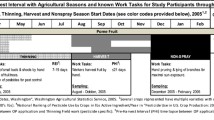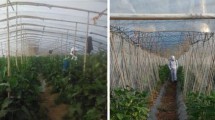Abstract
Deposits and residues of dioxathion disappear at similar rates on and in the rind of oranges and the leaves of orange trees; dislodgable residues on the leaves dissipate at the same rate as the penetrated residues. This fact is important in evaluating the potential hazard to workers in treated groves because their exposure to pesticide residues is principally through the dislodgable residues. Samples of vapor and particulate matter taken during violent shaking of the trees show that the exposure of workers is almost entirely through contact with, and inhalation of, particulate matter, dermal contact probably being the more important. In one experiment, pickers were used in trees sprayed with dust containing no toxicant to determine the actual weights of dust that are inhaled (using Unico air samplers) and that accumulate on their bare arms (by washing at ten-minute intervals). The data show that several times as much dust is contacted dermally than is inhaled. Washing the entire trees with a dilute detergent solution removes a significant part of the dislodgable residue; as much as 30 percent is removed 46 days after spraying. The data presented in this paper provide a guide for toxicologists to permit the design of tests required to evaluate hazards workers encounter in pesticide-citrus groves.
Similar content being viewed by others
References
Bailey, J. B., D. Mengle, and D. H. Flaherty: Pesticide residues on grape leaves evaluated for adverse effects on grape pickers as related to “worker reentry periods.” Unpublished report (1972).
Carman, G. E., W. E. Westlake, and F. A. Gunther: Potential residue problem associated with low-volume sprays on citrus in California. Bull. Environ. Contam. Toxicol.8, 38 (1972).
Gunther, F. A.: Insecticide residues in California citrus fruits and products. Residue Reviews28, 1 (1969).
Gunther, F. A., L. R. Jeppson, J. H. Barkley, R. C. Blinn, and C. L. Dunn: Persistence of residues of 2, 3-p-dioxanedithiolS, S-bis (O, O-diethyl phosphorodithionate) as an acaricide on and in mature lemons and oranges. J. Agr. Food Chem.6, 210 (1958).
Gunther, F. A., W. E. Westlake, J. H. Barkley, W. Winterlin, and L. Langbehn: Establishing dislodgable pesticide residues on leaf surfaces. Bull. Environ. Contam. Toxicol., in press (1973).
Author information
Authors and Affiliations
Rights and permissions
About this article
Cite this article
Westlake, W.E., Gunther, F.A. & Carman, G.E. Worker environment research: Dioxathion (delnav®) residues on and in orange fruits and leaves, in dislodgable particulate matter, and in the soil beneath sprayed trees. Arch. Environ. Contam. Toxicol. 1, 60–83 (1973). https://doi.org/10.1007/BF02030146
Received:
Accepted:
Issue Date:
DOI: https://doi.org/10.1007/BF02030146




